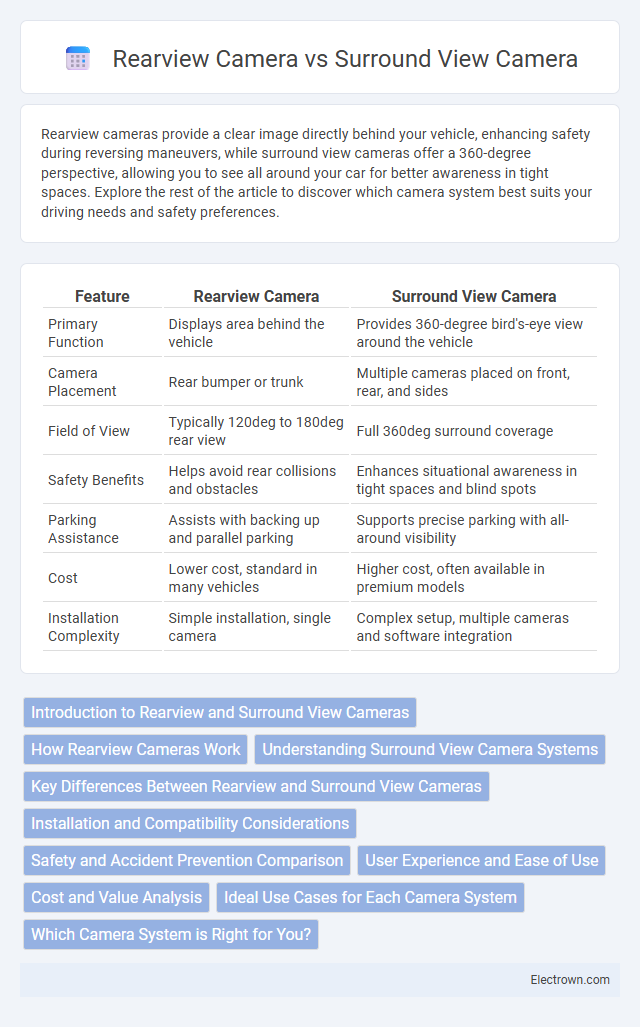Rearview cameras provide a clear image directly behind your vehicle, enhancing safety during reversing maneuvers, while surround view cameras offer a 360-degree perspective, allowing you to see all around your car for better awareness in tight spaces. Explore the rest of the article to discover which camera system best suits your driving needs and safety preferences.
Table of Comparison
| Feature | Rearview Camera | Surround View Camera |
|---|---|---|
| Primary Function | Displays area behind the vehicle | Provides 360-degree bird's-eye view around the vehicle |
| Camera Placement | Rear bumper or trunk | Multiple cameras placed on front, rear, and sides |
| Field of View | Typically 120deg to 180deg rear view | Full 360deg surround coverage |
| Safety Benefits | Helps avoid rear collisions and obstacles | Enhances situational awareness in tight spaces and blind spots |
| Parking Assistance | Assists with backing up and parallel parking | Supports precise parking with all-around visibility |
| Cost | Lower cost, standard in many vehicles | Higher cost, often available in premium models |
| Installation Complexity | Simple installation, single camera | Complex setup, multiple cameras and software integration |
Introduction to Rearview and Surround View Cameras
Rearview cameras provide a live video feed of the area directly behind your vehicle, enhancing safety by reducing blind spots during reversing. Surround view cameras utilize multiple cameras positioned around the car to create a 360-degree bird's eye view, offering comprehensive spatial awareness for parking and maneuvering in tight spaces. These advanced camera systems integrate with your vehicle's display to improve visibility and prevent collisions.
How Rearview Cameras Work
Rearview cameras use a single wide-angle lens mounted at the back of the vehicle to capture real-time video, which is transmitted to a display screen inside the car, aiding in reversing and parking. These cameras rely on image sensors and digital processing to deliver clear visuals of the area directly behind the vehicle, reducing blind spots and enhancing safety. Unlike surround view cameras, rearview cameras provide a focused, rear-only perspective, simplifying driver awareness during backing maneuvers.
Understanding Surround View Camera Systems
Surround view camera systems provide a 360-degree view around a vehicle using multiple synchronized cameras, enhancing situational awareness and safety during parking and low-speed maneuvers. Unlike rearview cameras that only display the area behind the vehicle, surround view systems stitch images from front, rear, and side cameras to create a bird's-eye perspective, reducing blind spots. Advanced algorithms process these inputs in real-time, offering drivers comprehensive visual information to prevent collisions and improve navigation in tight spaces.
Key Differences Between Rearview and Surround View Cameras
Rearview cameras provide a wide-angle view directly behind your vehicle, enhancing safety during reversing by reducing blind spots. Surround view cameras combine multiple camera inputs from around your car to create a 360-degree bird's-eye image, offering comprehensive situational awareness for parking and tight maneuvers. The key difference lies in the coverage area, with rearview cameras focusing solely on the rear and surround view cameras delivering a full perimeter perspective.
Installation and Compatibility Considerations
Rearview cameras generally offer easier installation with universal compatibility across most vehicles, often integrating seamlessly with existing display screens or aftermarket monitors. Surround view cameras require more complex installation involving multiple camera units around the vehicle and specialized control modules, which may limit compatibility to specific makes and models. Ensuring your vehicle's electrical system and infotainment setup support these advanced systems is essential for optimal performance and integration.
Safety and Accident Prevention Comparison
Rearview cameras primarily enhance safety by providing a clear view directly behind your vehicle, reducing blind spots and helping prevent collisions while reversing. Surround view cameras offer a 360-degree perspective, enabling you to detect obstacles and pedestrians around the entire vehicle, significantly increasing accident prevention during parking and tight maneuvering. Choosing between these systems depends on your safety needs, with surround view cameras offering more comprehensive protection in complex environments.
User Experience and Ease of Use
Rearview cameras provide a straightforward user experience by displaying a clear, direct image of what is behind the vehicle, enhancing ease of use during parking and reversing. Surround view cameras offer a comprehensive 360-degree view with stitched images from multiple cameras, which improves spatial awareness but can require some adjustment to interpret the composite image. The surround view system's enhanced perspective reduces blind spots and increases confidence in tight spaces, whereas the rearview camera prioritizes simplicity and immediate visual feedback.
Cost and Value Analysis
Rearview cameras typically cost between $50 and $200, offering essential rear visibility at an affordable price, which makes them ideal for budget-conscious consumers. Surround view cameras, priced from $500 to over $1,500, provide a 360-degree perspective around the vehicle, significantly enhancing safety and convenience but at a higher investment. The value of surround view systems lies in their comprehensive situational awareness, reducing blind spots and parking errors, which can justify the elevated cost for drivers prioritizing advanced safety features.
Ideal Use Cases for Each Camera System
Rearview cameras are ideal for parking assistance and improving rear visibility in tight spots, enhancing safety during reversing maneuvers. Surround view cameras provide a comprehensive 360-degree view, making them perfect for complex environments like crowded parking lots and off-road driving, where full situational awareness is critical. Both systems significantly reduce blind spots, but surround view cameras offer superior spatial orientation for advanced navigation.
Which Camera System is Right for You?
Rearview cameras provide a clear view of the area directly behind your vehicle, enhancing safety during reversing and parking. Surround view cameras offer a 360-degree perspective by combining multiple camera feeds, ideal for complex parking situations and tight spaces. Your choice depends on driving habits and parking needs, with rearview cameras suiting basic backup safety while surround view systems deliver comprehensive situational awareness.
Rearview camera vs Surround view camera Infographic

 electrown.com
electrown.com